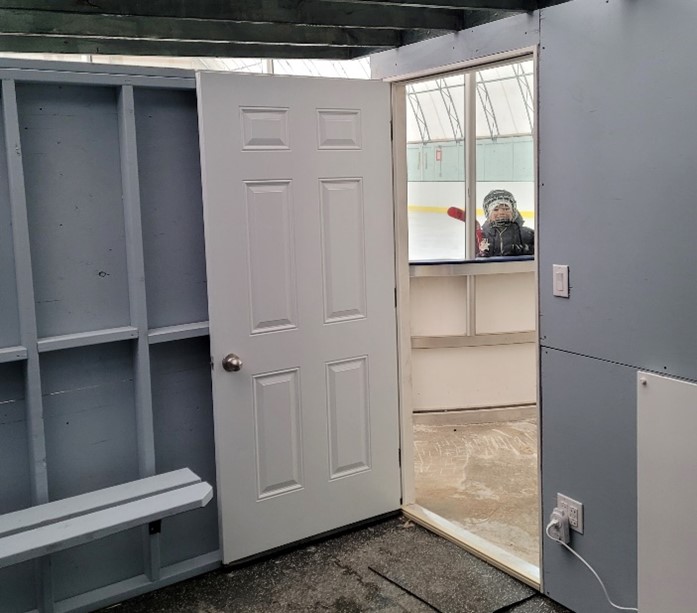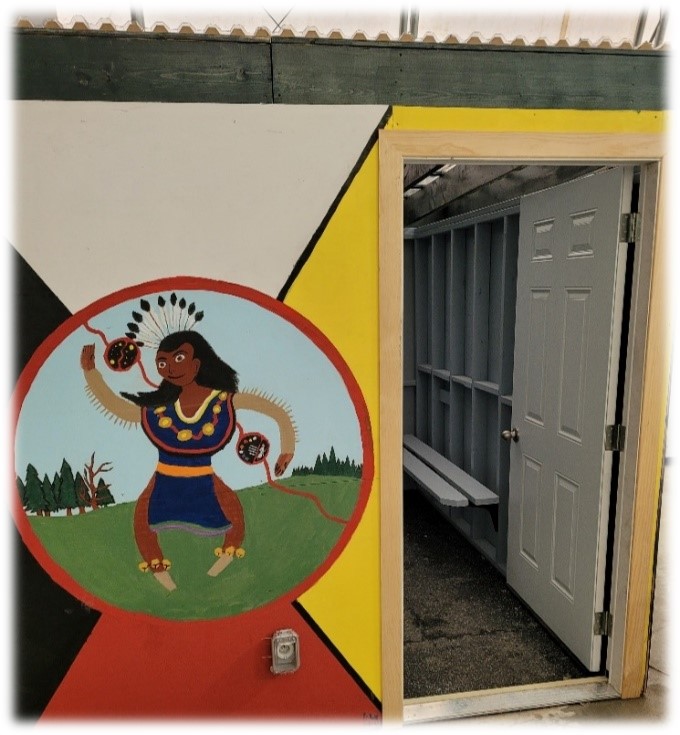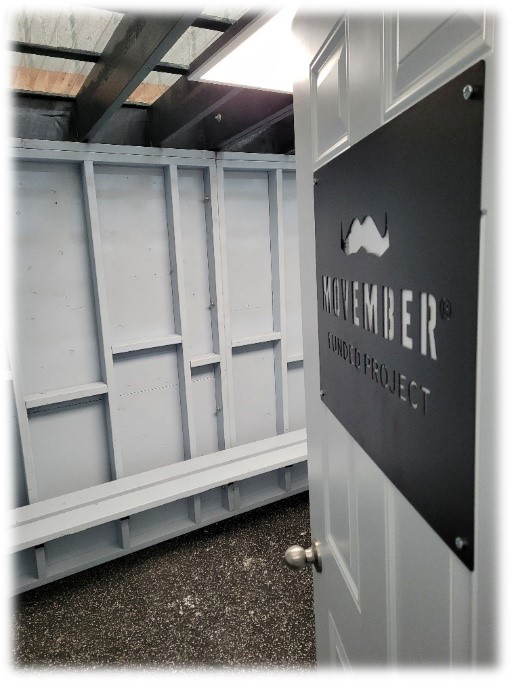Offenders build arena bleachers, skills and community pride
Let's Talk > Read our stories > Offenders build arena bleachers, skills and community pride

Offenders build arena bleachers, skills and community pride
This article was originally published in August 2023


The little hockey player with the red stick peeked through the glass into the new change room. He had a personal interest in the construction taking place at the Taykwa Tagamou Nation community arena. He would be using this change room. And his grandparents would soon be sitting on the new bleachers watching him skate.
The young skater observed as a team from Correctional Service Canada (CSC) arrived to install two bleachers, two change rooms, two hockey benches, and a scorekeeper’s bench. It was the end of January and Taykwa Tagamou Nation, near Cochrane in northeastern Ontario, was in a deep freeze with minus 35 Celsius temperatures.
The cold did not interrupt the team who were there to assemble prebuilt change rooms and fit the bleachers and benches into place around the rink inside the large, white Quonset hut. These were no ordinary change rooms and benches. They were built by Indigenous offenders for Indigenous communities and symbolized a gathering place for healing.
The arena’s new wooden structures were constructed and painted by participants in the Collins Bay and Beaver Creek institutions’ Work to Give (W2G) Program. Joyceville Institution Indigenous offenders also crafted six traditional hand drums as a gift for the community’s pathways program for Indigenous youth.
Working to give back
W2G is an Indigenous-led, Indigenous-focused program that provides opportunities critical for Indigenous offenders’ well-being and rehabilitation. The program partners with the not-for-profit organizations Movember and True North Aid for funding and support. Robert Rittwage, Project Lead with W2G noted the program’s secondary purpose: “to build Indigenous leadership capacity” that will inspire W2G participants to succeed throughout their correctional journey and positively influence the next generation of Indigenous community members.
W2G staff meets with various Ontario Indigenous communities to identify their specific needs, such as wooden garden boxes, picnic tables, school bus shelters, bear-proof garbage disposal units, or floating docks. Then, W2G participants in the institutions build it. The Taykwa Tagamou Nation needed to outfit its arena to make it a fully functional, vibrant community space.

Indigenous staff at Collins Bay and Beaver Creek institutions were enlisted to work with offenders in both the medium and minimum-security facilities to create the change rooms and bleachers. The offenders learned employable skills building these items. It was the first time many of them had used a paintbrush, hand saw, or drill.
This on-the-job construction training was guided by CORCAN. The special operating agency within Beaver Creek Institution provides opportunities for offenders to develop marketable skills, helping them find employment and successfully re-integrate into society.
W2G promotes good energy
W2G focuses on a positive, holistic opportunity for offenders. Throughout the construction of the items, Elders were on-site, providing culturally relevant ceremonies and teachings, as well as Indigenous storytelling and smudging. Indigenous offenders gained carpentry skills, while improving their emotional/mental well-being, which gave them a sense purpose.
“We start out with a Smudge to bring our hearts, our minds and our spirits together, then set our good intentions to be able do those things in a good way,” said Robert. “Sharing that positive energy and those traditional teachings—that good energy goes into the things we build and the items that are given away.”

The good energy carried everyone through the entire build. After the team had completed the installation at the arena, they held a special ceremony on January 31 to gift it to the community. Taykwa Tagamou Nation Chief Bruce Archibald, other leaders and community members, along with Sonia Prevost-Derbecker from Movember, Regional Deputy Commissioner Kevin Snedden, Regional Administrator of Indigenous Initiatives Jamie Contois, Ontario Regional Manager of Operations for CORCAN Detlef Fischer, Robert, and W2G participants were there to celebrate the event.
Robert noted how appreciative the community members were of the items built specifically for their arena.
The community is definitely also appreciative of the reintegration opportunities and helping Indigenous participants make different decisions in their lives.
"Now they make those decisions based on the skills learned, the cultural experience, and the camaraderie they develop in this program,” said Robert.
He noted that this is an example of how W2G is a win-win for both community and offenders.
The program “makes all the difference in the world” for the participants who are able to better themselves and the opportunity it creates for Indigenous communities. Robert said, “It is a concrete step toward true reconciliation and effective rehabilitation.”
Building and then installing the arena’s interior items fostered a sense of pride in each W2G participant. They knew they helped create a place where kids could sit, put on their skates, and work toward their dreams of becoming the next generation of professional hockey players, while their families watch from the bleaches and cheer them on.

